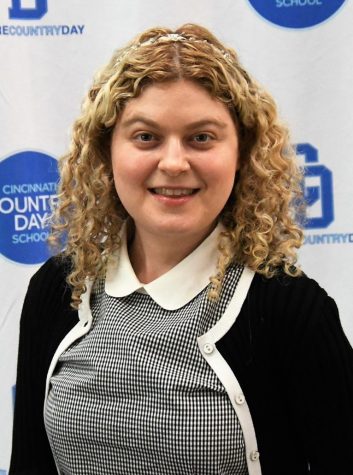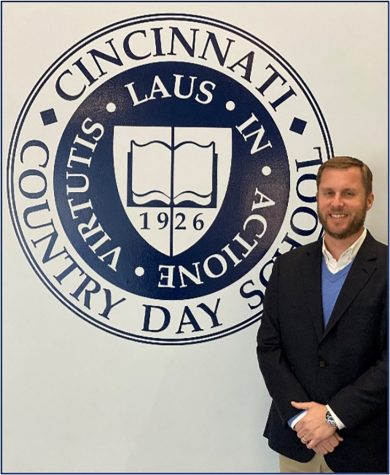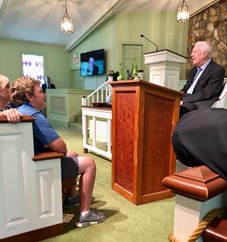Teaching Students to Talk about Racism
September 28, 2020
Before Angela Barber-Joiner was appointed the Director of Equity, Diversity, and Inclusion (EDI) last year, she had already been providing families with a safe space to express their needs with a person of color. The EDI Director position was created to continue these conversations as well as to fulfill the school’s promise of “preparing students for college and life” as stated in the mission statement. “If we’re preparing students for college and life,” said Mrs. Barber-Joiner, “one big piece is preparing children to be able to navigate conversations with all people.”
From a student perspective, conversations in school about topics such as race, sexism, bias, or simply political beliefs are often confrontational. Lauren Hettinger ’21 said, “When students talk about politics, there are never questions involved. People are just stating their opinions.” Another student identified the school’s environment as “uncomfortable” for conservative students who often find their beliefs challenged by other students. “There’s never a conclusion to political discussions,” said Maggie Gardner ’21.
With the events of this past summer still simmering and the election approaching, there’s a lot for us to process this year. Students want to discuss difficult topics, but would prefer a structure to keep the conversation from turning into a debate. Mrs. Barber-Joiner’s job is to help faculty examine the curriculum with regards to inclusivity and create a classroom environment where meaningful conversations about injustices can take place.
This year, Mrs. Barber-Joiner joins the cabinet to work directly with faculty and administrators on implementing these initiatives in the classroom. This summer, the faculty read Matthew Kay’s Not Light, But Fire: How to Lead Meaningful Race Conversations in the Classroom. Kay encourages educators not to shy away from conversations about difficult topics such as race or politics but rather to have them intentionally. Mrs. Barber-Joiner notes that the principal action in these conversations is listening; “listen actively, patiently, and intentionally. Mind your voice so that other voices are not silenced.” When the discussion comes to an end, Kay makes a point to reflect on what stood out in the conversation and what questions have come out of it.
Some might say that high school is an inappropriate time to discuss such complex issues. “It is the best time,” Mrs. Barber-Joiner assures us. “This is our one opportunity before we send students out into the world… to prepare students to have a conversation that is not only meaningful but gives empathy.”
Additionally, in a classroom setting, we have the freedom to make mistakes in difficult conversations and try again. “We can help guide the conversation and remind students of key ways to have a conversation—to practice it, reflect on how the conversation went, and go back to the framework and practice it again with the next conversation. You don’t really have that opportunity outside of a classroom.”
“If we’re genuinely preparing [students] for college and life, the conversation piece and the social intelligence piece are just as important as the academic piece. If you cannot navigate a conversation with all people, it’s going to be very challenging in this new world to be effective in the workplace. That’s why it’s so important for us to do it right here.”
In terms of the curriculum, Mrs. Barber-Joiner will be working individually with teachers to include multiple perspectives in the classroom. This includes “bringing in other literature or other ways to support the whole narrative so that all students can connect with the story.”
In English class, it seems to students that many of the books we read were written by, as one student said, “old White people.” Mrs. Barber-Joiner talks about the need for a complete narrative where all students can find their experiences in the discussion. How do students who aren’t old, White people relate to the story? What its significance today in our increasingly diverse world? Or when we read novels by Black authors, we might ask, how does the Black Lives Matter movement connect to the civil rights movement? What does Black Lives Matter mean? “We can have those challenging conversations with literature,” Mrs. Barber-Joiner says. “Often times, we overlook opportunities with literature to delve into what’s happening now. So I would help that teacher dive into that literature while allowing every voice to be heard in the room.”
But what about when the adults aren’t around? We find ourselves in hallway debates every day as we navigate clashing political beliefs and personal experiences. In these moments, Mrs. Barber-Joiner encourages us to “ask questions and listen. Find a way to connect with the other person and understand their experiences.” Rather than attempting to solve the issue, the goal of the conversation is to learn from the other person.
Secondly, she reminds us that we can stand up to bias when we are confronted with it. She mentions the acronym IQEE; Interrupt, Question, Educate, Echo. “Simply interrupt and question by saying, ‘Stop for a minute. Tell me what you mean by that?’” An article from Teaching Tolerance mentions the importance of asking the speaker to explain why they used insensitive language to “lead them to encounter their own blind spots or [prejudices].” Next is Educate. Mrs. Barber-Joiner gives an example of how to calmly explain a situation; “I hear you. You’re thinking that person looks scary because you’ve seen people on the news who look like that who are up to something. But you know, we’re all individuals. That may not be their story.” Finally, Echo. If you see someone else standing up to bias, you have the power to support them and help reinforce their point. “It’s my hope that we’re intentionally teaching students how to do that as well as practicing it ourselves as a faculty.”
If students ever do witness or receive bias, Mrs. Barber-Joiner’s door is always open, to students of any background. “Stop in my office or send me an email. We also have an Equity Diversity and Inclusion council that can serve as a student support system and then relay that information to me. The information will not be shared unless [a student] asks for it to be shared. Throughout last school year, there were students who reported things to me, and I did not share their names unless they asked me to, but I was still able to take action and have meaningful change happen. Because the whole purpose of reporting is either for change to happen or for reflection and support to happen. I am here to offer both; change and support.”
Students should begin to see more of these conversations taking place in their classrooms, but it’s important to note that these topics are difficult for students and teachers alike, and the change is new for all of us. Head of School Mr. Jaccaci said, “As teachers, it is our professional responsibility to teach students how to think, not what to think. However, we do have our own opinions and deeply held beliefs too. So the question is, how do we share them in a discussion without imposing them and welcome and foster student voice from all perspectives?” It is a question we hope to dive into this year.













